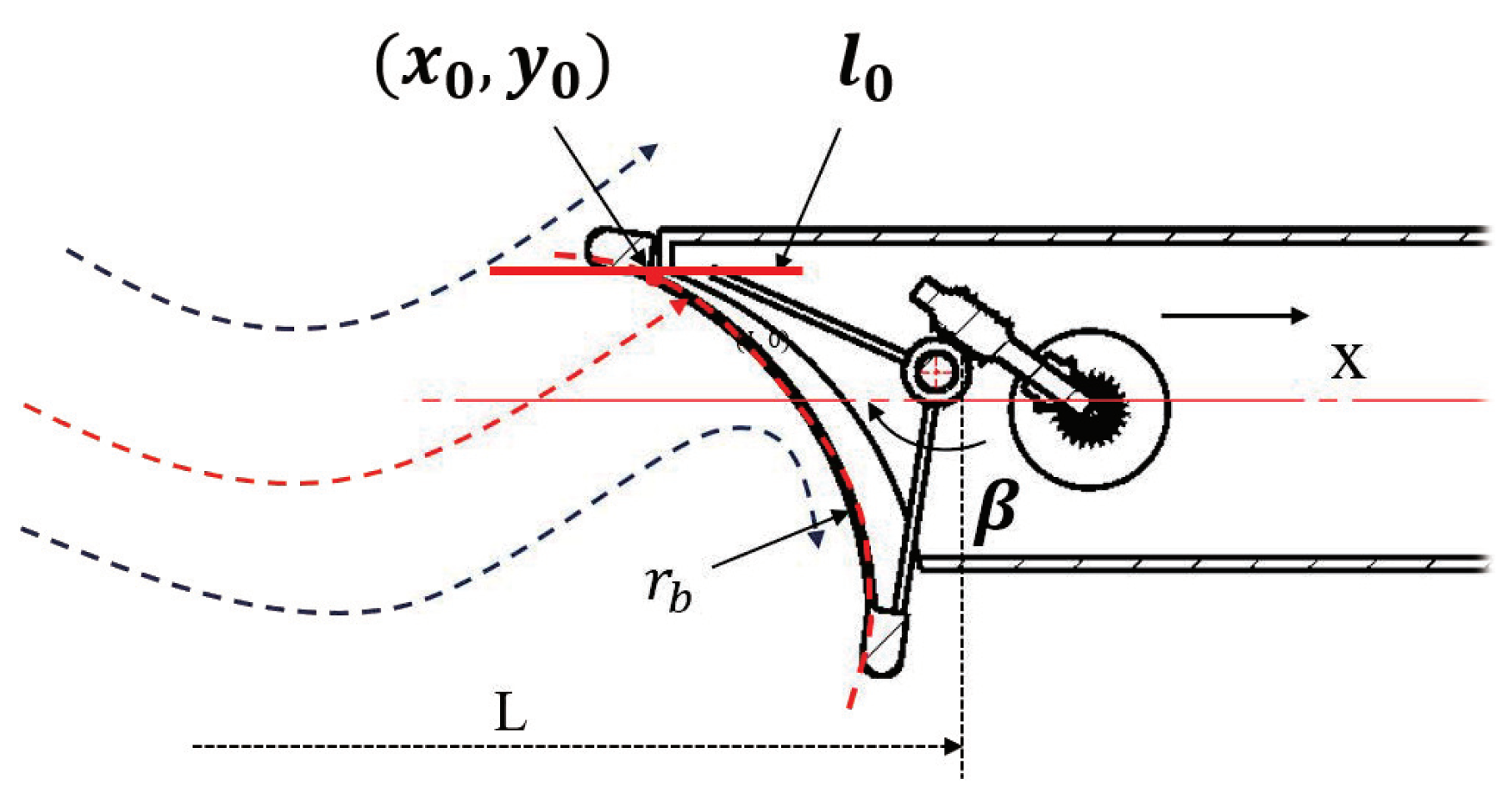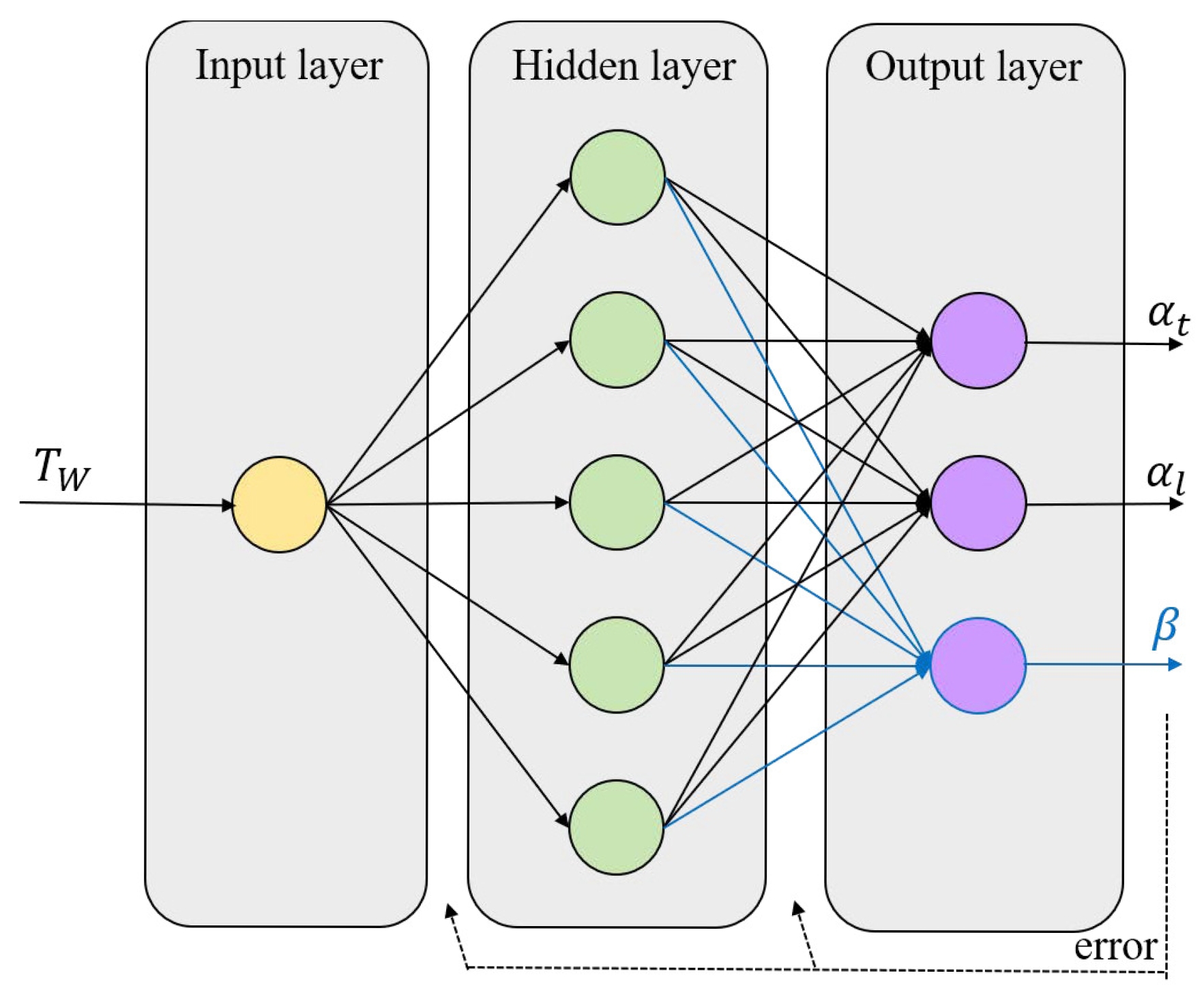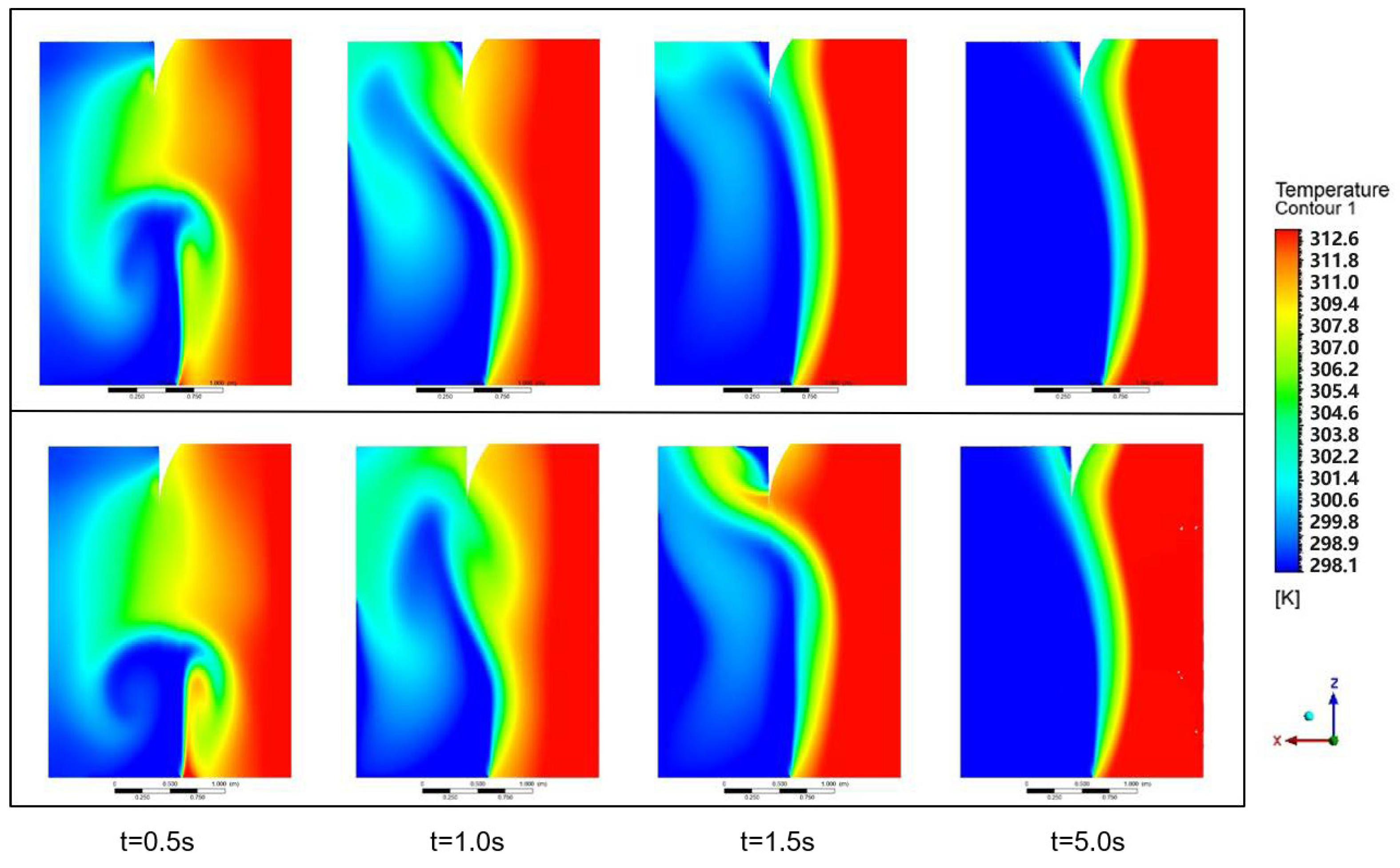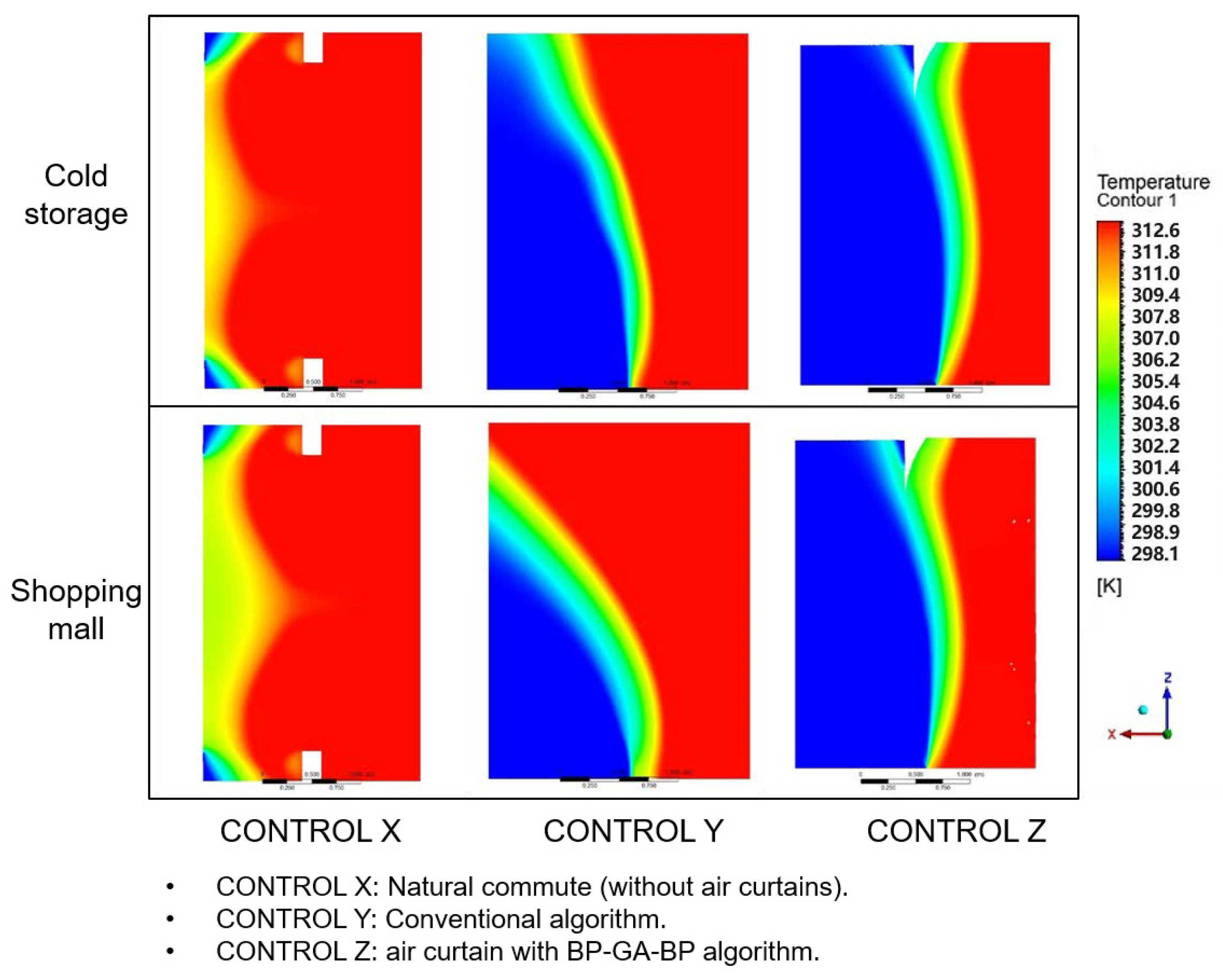Angle Control Algorithm for Air Curtain Based on GA Optimized Quadratic BP Neural Network
Abstract
:1. Introduction
- The introduction of a novel BP-GA-BP neural network algorithm addresses the limitations of current theoretical methods and simulation models by achieving the best performance of both real-time monitoring and high accuracy. It enables real-time calculation and adjustment of multiple angles with changing working conditions.
- The proposed algorithm demonstrates improved airtightness compared to traditional control methods. The approach also requires fewer iterations, offers high computational efficiency, and achieves high fitting accuracy compared to other intelligent algorithms.
- Utilizing the BP-GA-BP algorithms to bridge the gap in intelligent real-time control of air curtain angles enhances the accuracy of the computational model, laying the groundwork for future research in this domain.
2. Architecture of the Angle Control System
- Data Characterization. To achieve real-time control of the angle, a prediction model for the temperature-jet angle is initially established. The first BP neural network based on the gradient descent algorithm, designed for predicting the jet angle, is developed using Hayes air curtain model data [4].
- Angle scheme optimization. However, traditional BP neural networks are incapable of accurately predicting the windshield angle based on the available dataset during training. To address this limitation, the study further involves the analysis and optimization modeling of the jet binary divergence problem at the windshield. The primary objective of the model is to minimize the fitness function associated with jet angles and windshield angles, aiming to closely align the performance target with the divergence target point.
- Angle scheme training. Following the acquisition of the optimal solution set for jet angles and windshield angles through GA global search, the predictive model and optimal solution set are retrained using the BP neural network to develop the neural network model for temperature-jet angles and windshield angle.
- Airtightness verification by CFD simulation. Moreover, the airtightness under varying control strategies and the efficacy of diverse neural network algorithms are evaluated, and the enhancement in airtightness and real-time performance is confirmed through CFD simulation.
3. BP-GA-BP Neural Network Modeling
3.1. Quadratic BP Neural Network Modeling
3.2. Structure and Flow Analyse
3.3. Optimization Problem Modeling
4. CFD Simulation Procedure
4.1. Airtightness Indication
4.2. Simulation
5. Verification and Discussion
5.1. Airtightness Verification
5.1.1. Proposed BP-GA-BP Algorithm
5.1.2. Comparison with Other Control Schemes
5.1.3. Comparison with Experimental Results
5.2. Algorithm Performance Verification
5.2.1. Proposed BP-GA-BP Algorithm
5.2.2. Comparison with Other Algorithms
6. Conclusions
- The introduction of an innovative BP-GA-BP neural network algorithm, which exhibits enhanced airtightness, surpassing both conventional control strategies and existing intelligent algorithms. The proposed algorithm yielded 26.5% and 43.9% improvements under two distinct operational scenarios.
- Resolution of limitations in existing theoretical methodologies and simulation models for air curtains, enabling real-time monitoring and more precise adjustments in multiple angle calculations. The BP-GA-BP algorithm, in comparison to the conventional approach, achieved an 89% reduction in Epoch, and significant decreases in MSE, RMSE, and MAE by 97.8%, 86.4%, and 85.2%, respectively, as well as a stronger robustness.
- The application of artificial intelligence algorithms bridges the gap in intelligent real-time control of air curtain angles, offering a novel approach to advancing air curtain technology and contributing to energy conservation and emission reduction. This study sets the stage for future research in the field.
Author Contributions
Funding
Data Availability Statement
Conflicts of Interest
References
- Downing, C.C.; Meffert, A.W. Effectiveness of cold-storage door infiltration protective devices. Ashrae Trans. Am. Soc. Heat. Refrig.-Air-Cond. Eng. 1993, 99 Pt 2, 356–366. [Google Scholar]
- Azzouz, A.; Gosse, J.; Duminil, M. Experimental determination of cold loss caused by opening industrial cold-room doors. Int. J. Refrig. 1993, 16, 57–66. [Google Scholar] [CrossRef]
- Gil-Lopez, T.; Castejon-Navas, J.; Galvez-Huerta, M.A.; O’Donohoe, P.G. Energetic, environmental and economic analysis of climatic separation by means of air curtains in cold storage rooms. Energy Build. 2014, 74, 8–16. [Google Scholar] [CrossRef]
- Hayes, F.C.; Stocker, S.W. Heat transfer characteristics of air curtain. Ashrae Trans. Ons 1969, 1, 167–179. [Google Scholar]
- Jerning, G.E. Air curtain in the 70’s. Refrig. Air Cond. 1970, 3, 93–99. [Google Scholar]
- Sadowski; Mirosław; Kuriata, A.; Jelonek, B. Przestepstwo Pospolite Czy Podatkowe? Zbieg Czynów Zabronionych w Rozumieniu art. 8 s 1 k.k.s. w Swietle Najnowszego Orzecznictwa Sadu Najwyzszego. 2011. Available online: http://www.repozytorium.uni.wroc.pl/dlibra/publication/edition/65430 (accessed on 20 June 2024).
- Guyonnaud, L.; Solliec, C.; DeVirel, M.D.; Rey, C. Design of air curtains used for area confinement in tunnels. Exp. Fluids 2000, 28, 377–384. [Google Scholar] [CrossRef]
- Foster, A.M.; Swain, M.J.; Barrett, R.; D’Agaro, P.; Ketteringham, L.P.; James, S.J. Three-dimensional effects of an air curtain used to restrict cold room infiltration. Appl. Math. Model. 2007, 31, 1109–1123. [Google Scholar] [CrossRef]
- Foster, A.M.; Swain, M.J.; Barrett, R.; D’Agaro, P.; James, S.J. Effectiveness and optimum jet velocity for a plane jet air curtain used to restrict cold room infiltration. Int. J. Refrig. 2006, 29, 692–699. [Google Scholar] [CrossRef]
- Gonçalves, J.C.; Costa, J.J.; Lopes, A.M.G. Parametric study on the performance of an air curtain based on CFD simulations—New proposal for automatic operation. J. Wind. Eng. Ind. Aerodyn. 2019, 193, 103951. [Google Scholar] [CrossRef]
- Gonçalves, J.C.; Costa, J.J.; Figueiredo, A.R.; Lopes, A.M. CFD modelling of aerodynamic sealing by vertical and horizontal air curtains. Energy Build. 2012, 52, 153–160. [Google Scholar] [CrossRef]
- Gonçalves, J.C.; Costa, J.J.; Figueiredo, A.R.; Lopes, A.M.G. Study of the aerodynamic sealing of a cold store—Experimental and numerical approaches. Energy Build. 2012, 55, 779–789. [Google Scholar] [CrossRef]
- Rai, A.; Sun, J.; Tassou, S.A. Three-dimensional investigation on the positioning of air curtain on its effectiveness in refrigerated vehicles used for food distribution. Energy Procedia 2019, 161, 224–231. [Google Scholar] [CrossRef]
- Rai, A.; Sun, J.; Tassou, S.A. Numerical investigation of the protective mechanisms of air curtain in a refrigerated truck during door openings. Energy Procedia 2019, 161, 216–223. [Google Scholar] [CrossRef]
- Rai, A.; Sun, J.; Tassou, S.A. Numerical investigation into the influence of air curtain discharge angles in refrigerated trucks. Energy Procedia 2019, 161, 207–215. [Google Scholar] [CrossRef]
- Sun, J.; Tsamos, K.M.; Tassou, S.A. CFD comparisons of open-type refrigerated display cabinets with/without air guiding strips. Energy Procedia 2017, 123, 54–61. [Google Scholar] [CrossRef]
- Sihwan, L. Study on Energy Loss in Open-Gate Cooling (Part 1) Numerical Study on Ventilation Volume and Air Curtain Thermal Interception Characteristics in a Single Opening. 2018. Available online: https://jglobal.jst.go.jp/detail?JGLOBAL_ID=201802235597982264 (accessed on 22 June 2024).
- Li, X.; Zhang, M.; Jiang, Y.; Wang, L.; Zhao, X.; Chang, X.; Bai, H.; Deng, X. Air Curtain Dust-Collecting Technology: Investigation of Factors Affecting Dust Control Performance of Air Curtains in the Developed Transshipment System for Soybean Clearance Based on Numerical Simulation. Powder Technol. 2022, 396, 59–67. [Google Scholar]
- Xiu, Z.; Nie, W.; Cai, P.; Chen, D.; Zhang, X. Partially Enclosed Air Curtain Dust Control Technology to Prevent Pollution in a Fully Mechanized Mining Face. J. Environ. Chem. Eng. 2022, 10, 108326. [Google Scholar] [CrossRef]
- Nie, W.; Zhang, Y.; Guo, L.; Zhang, X.; Peng, H.; Chen, D. Research on Airborne Air Curtain Dust Control Technology and Air Volume Optimization. Process. Saf. Environ. Prot. 2023, 172, 113–123. [Google Scholar] [CrossRef]
- Wang, J.; Du, C.; Du, S.; Jin, W.; Fan, D. Dust Dispersion Law and High-Pressure Air Curtain Control Technology of Crossheading during the Process of Ore Unloading. J. Wind. Eng. Ind. Aerodyn. 2022, 230, 105179. [Google Scholar] [CrossRef]
- Shen, C.; Wang, D.; Zhang, J.; Bi, Q. A Novel Dual Swirling Air Curtain Dust-Control System: Design and Similar Experiment. J. Environ. Chem. Eng. 2024, 12, 113728. [Google Scholar] [CrossRef]
- Yu, L.; Chen, Y.; Chen, S.; Zhang, Y.; Zhang, H.; Liu, C. Numerical Analysis of the Performance of a PID-Controlled Air Curtain for Fire-Induced Smoke Confinement in a Tunnel Configuration. Fire Saf. J. 2023, 141, 103930. [Google Scholar] [CrossRef]
- Zhang, J.; Zhao, X.; Gao, Y. Shear strength prediction and failure mode identification of beam–column joints using bpnn, rbfnn, and grnn. Arab. J. Sci. Eng. 2023, 48, 4421–4437. [Google Scholar] [CrossRef]
- Li, Y.Y.; Zhang, F.; Su, J. Improvement of the bayesian neural network to study the photoneutron yield cross sections. Nucl. Sci. Tech. 2022, 33, 135. [Google Scholar] [CrossRef]
- Viegas, J.C.; Oliveira, F.; Aelenei, D. Experimental Study on the Aerodynamic Sealing of Air Curtains. Fluids 2018, 3, 49. [Google Scholar] [CrossRef]
- Claudio, A.R.; van Hooff, T.; Blocken, B.; van Heijst, G. Air Curtain Performance: Introducing the Adapted Separation Efficiency. Build. Environ. 2021, 188, 107468. [Google Scholar]
- Ruiz, C.A.; van Hooff, T.; Blocken, B.; van Heijst, G. Restriction of Air Infiltration by an Air Curtain Optimized with Secondary Jets—A Numerical Investigation. In Proceedings of the ASHRAE Topical Conference Proceedings, Denver, CO, USA, 10–12 November 2021. Indoor Air Quality. [Google Scholar]
- Tang, X.L.; Shi, Z.Z. Theoretical study on sealing characteristics of gas curtain under lateral flow. Build. Heat Vent. Air Cond. 1999, 2, 6–8. [Google Scholar]
- Sahoo, L.; Mahato, S.K.; Bhunia, A.K. Optimization of system reliability in the imprecise environment via genetic algorithm. Int. J. Swarm Intell. Res. 2022, 13, 1–21. [Google Scholar] [CrossRef]
- Brown, W.G.; Solvason, K.R. Natural convection through rectangular openings in partitions—1: Vertical partitions. Int. J. Heat Mass Transf. 1962, 5, 859–868. [Google Scholar] [CrossRef]
- Tamm, W. Kalterveluste durch kuhlraumoffnungen. Kaltetechnik-Klimatisierung 1966, 18, 142–144. [Google Scholar]
- Fritzsche, C.; Lilienblum, W. Neue messengun zur bestimmung der kalterluste an kuhlraumturen. Kaltetechnik-Klimatisierung 1968, 20, 279–286. [Google Scholar]
- Gosney, W.B.; Olama, H.; Levy, F. Heat And Enthalpy Gains Through Cold Room Doorways. Inst. Refrig. Proc. 1976, 72, 31–41. Available online: http://pascal-francis.inist.fr/vibad/index.php?action=getRecordDetail&idt=PASCAL7870469733 (accessed on 27 September 2024).
- Pham, Q.T.D.; Oliver, W. Infiltration of Air into Cold Stores. Meat Institute of New Zealand 16th Internat 1983, Volume 6. Available online: https://www.aivc.org/resource/infiltration-air-cold-stores#:~:text=Measures%20air%20exchange%20across%20open%20cold%20store%20doors%20using%20an (accessed on 27 September 2024).
- Zhang, H.; Cheng, J.; Zhang, J.; Liu, H.; Wei, Z. A Regularization Perspective Based Theoretical Analysis for Adversarial Robustness of Deep Spiking Neural Networks. Neural Netw. 2023, 165, 164–174. [Google Scholar] [CrossRef]









| Condition | Airtightness (%) | Improvement (%) | ||
|---|---|---|---|---|
| CONTROL X | CONTROL Y | CONTROL Z | Z vs. Y | |
| Cold storage | 0 | 68 | 86 | 26.5 |
| Shopping mall | 0 | 57 | 82 | 43.9 |
| Condition | Airtightness (%) | Improvement (%) | ||
|---|---|---|---|---|
| CONTROL X | CONTROL Y | CONTROL Z | Z vs. Y | |
| Cold storage | 0 | 63.6 | 80.3 | 26.3 |
| Shopping mall | 0 | 51.2 | 72.4 | 41.4 |
| No. | Algorithm | Epoch | MSE | MAE | RMSE | |
|---|---|---|---|---|---|---|
| 1 | Polynomial Curve Fitting + Newton’s method + BP | 879 | 0.119900 | 0.09122 | 0.109541 | 0.9927 |
| 2 | BP + Newton’s method + BP | 864 | 0.070589 | 0.06951 | 0.084088 | 0.9987 |
| 3 | Polynomial Curve Fitting (PCF) + GA + BP | 256 | 0.004161 | 0.01404 | 0.020397 | 0.9959 |
| 4 | BP + GA + BP | 122 | 0.002691 | 0.01239 | 0.016097 | 0.9987 |
| Number of Samples | PCF + GA + BP | BP + GA + BP | ||
|---|---|---|---|---|
| Time (s) | Time (s) | |||
| 50 | 4.7877 | 0.9578 | 8.5258 | 0.8432 |
| 100 | 4.855 | 0.9740 | 9.1545 | 0.8661 |
| 500 | 4.9448 | 0.9831 | 11.6454 | 0.9234 |
| 1000 | 4.9672 | 0.9928 | 12.4534 | 0.9464 |
| 1500 | 5.0352 | 0.9970 | 13.0576 | 0.9831 |
| 2000 | 5.3171 | 0.9929 | 13.5678 | 0.9959 |
| 3000 | 5.2788 | 0.9928 | 13.5678 | 0.9942 |
Disclaimer/Publisher’s Note: The statements, opinions and data contained in all publications are solely those of the individual author(s) and contributor(s) and not of MDPI and/or the editor(s). MDPI and/or the editor(s) disclaim responsibility for any injury to people or property resulting from any ideas, methods, instructions or products referred to in the content. |
© 2024 by the authors. Licensee MDPI, Basel, Switzerland. This article is an open access article distributed under the terms and conditions of the Creative Commons Attribution (CC BY) license (https://creativecommons.org/licenses/by/4.0/).
Share and Cite
Zhao, Y.; Shuai, L.; Zhang, H.; Zheng, Y. Angle Control Algorithm for Air Curtain Based on GA Optimized Quadratic BP Neural Network. Buildings 2024, 14, 3144. https://doi.org/10.3390/buildings14103144
Zhao Y, Shuai L, Zhang H, Zheng Y. Angle Control Algorithm for Air Curtain Based on GA Optimized Quadratic BP Neural Network. Buildings. 2024; 14(10):3144. https://doi.org/10.3390/buildings14103144
Chicago/Turabian StyleZhao, Yuxi, Liguo Shuai, Haodong Zhang, and Yuhang Zheng. 2024. "Angle Control Algorithm for Air Curtain Based on GA Optimized Quadratic BP Neural Network" Buildings 14, no. 10: 3144. https://doi.org/10.3390/buildings14103144
APA StyleZhao, Y., Shuai, L., Zhang, H., & Zheng, Y. (2024). Angle Control Algorithm for Air Curtain Based on GA Optimized Quadratic BP Neural Network. Buildings, 14(10), 3144. https://doi.org/10.3390/buildings14103144






